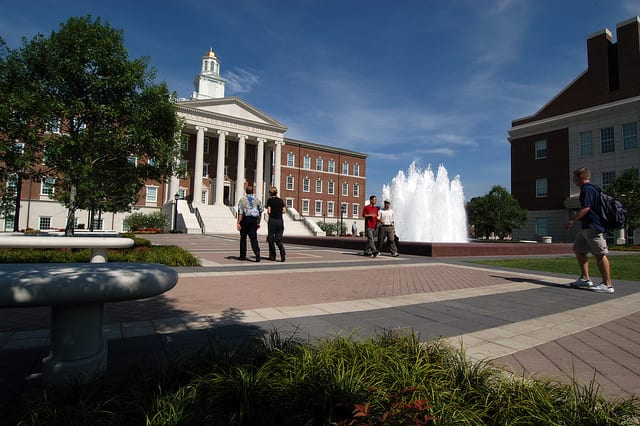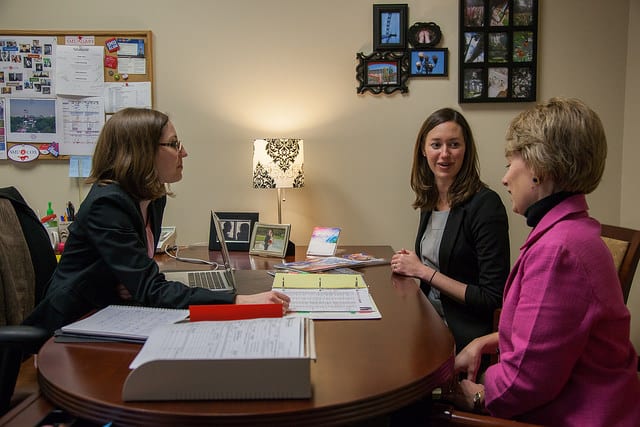The nature and character of religious communities in the American Midwest hold a special attraction for Andrew Klumpp, Ph.D. student in religious studies in Dedman College. He wants to know if religious groups in this region helped to form a distinct Midwestern culture and how Midwestern religious roots helped shape the ideologies, policies and careers of national figures who hail from the heartland of America.
Klumpp is one of 12 SMU doctoral students who received the first University Ph.D. Fellowships created from funds that were saved through the OE2C (Operational Excellence for the Second Century) project in 2015. OE2C aims to secure the long-term economic vitality of SMU through operational improvements and savings that are applied to its academic mission. Starting with $150,000 for the program’s first year, graduate fellowships up to $10,000 were awarded in spring 2015 to 12 high-achieving students in a variety of SMU’s 22 doctoral programs. The Ph.D. Fellowship program will support eight additional Ph.D. fellows, who will join SMU in the fall. OE2C has captured $15.1 million in savings to date, with $13.8 million applied toward the academic mission.
Among numerous benefits reaped from SMU’s fellowship funding, not having to take jobs to make ends meet was foremost for Klumpp. “During the first year of my program, I presented a historical exhibit featuring my work at Duke University, gave a scholarly paper at a regional meeting, co-authored a chapter in an upcoming book on religion and U.S. politics, and contributed articles to journals in my field. Many of these opportunities were the result of having the financial security necessary to devote time and resources to my own travel, research and writing,” he says.
For Asiel Sepúlveda, doctoral student in the rhetorics of art, space and culture program in art history, the fellowship funds enabled him to participate in a printmaking workshop hosted by the Association of Print Scholars at the Rhode Island School of Design. “My interests include 19th-century visual culture, commercial advertising and urban studies with an emphasis on Latin America and the Caribbean. This workshop provided me with a unique opportunity to operate a lithographic press so that I could fully understand the processes and techniques used by lithographic printers in the 19th century,” he says.
The research fellowship also supported archival work for Grace Vargas, a historian of global Christianity in religious studies, and allowed her to network with other scholars beyond her discipline. Vargas’ doctoral research centers on a postcolonial and critical analysis of U.S. Protestant missions in Cuba at the turn of the 20th century. “Most of the historiography on these missions focuses on the influence and contributions of U.S. missionaries to the island. I am interested in widening the lens to show Cuban influence on, and contributions to, this enterprise,” she says.
According to Associate Vice President for Research and Dean of Graduate Studies James Quick, increasing the number of Ph.D. students will provide benefits to the University as a whole. “These are outstanding students poised to make significant contributions to their fields, and we are proud to have them join the SMU community. Outstanding graduate students add to the educational experience of SMU’s undergraduates and serve as role models. A key part of the continued growth and development of SMU’s graduate programs is bringing these top students to the University, and their presence will have a positive impact in their departments and beyond.”
The SMU Faculty Senate, in its resolution of December 4, 2013, urged SMU to create University-wide fellowships for doctoral students, saying they “play a crucial role in engaging and interfacing with undergraduate students in faculty research projects that in turn helps us recruit high-quality undergraduates and raise the academic quality of the incoming class … and … [that] doctoral students are the future leaders of research, innovation and scientific progress, of creative enterprise and arts, and of great scholarship, all of which are some of the longest lasting contributions and legacies that SMU can make to the local economy and community. …”
In addition to the creation and awarding of the University-wide fellowships, initiatives undertaken over the past year and a half have offered other new academic opportunities. For example, using reallocated funds, the University has provided increased, round-the-clock access to ManeFrame, one of the most powerful, high-performance computers in the United States, enabling large-scale research opportunities for SMU faculty and students.





